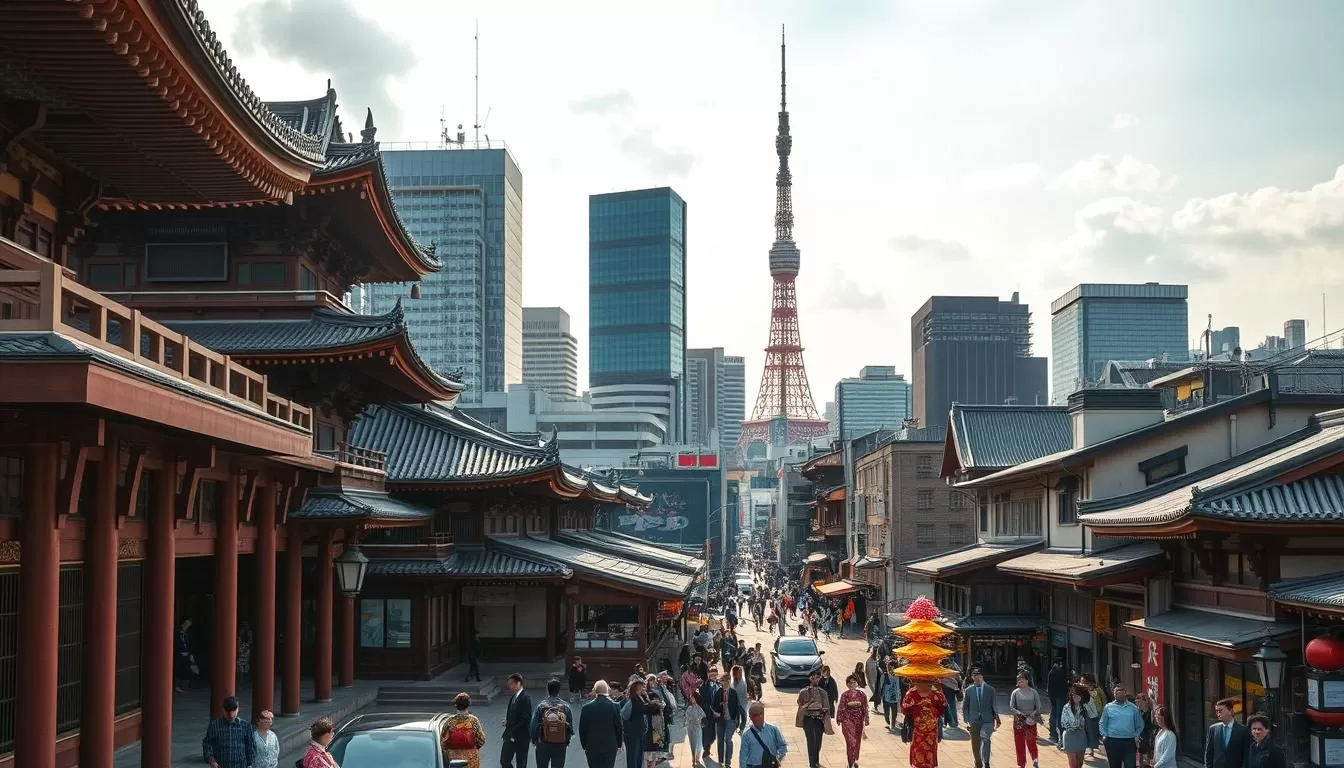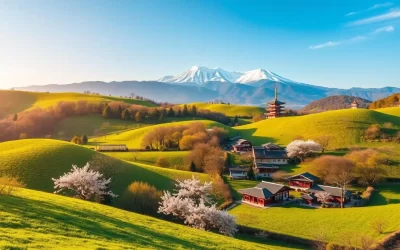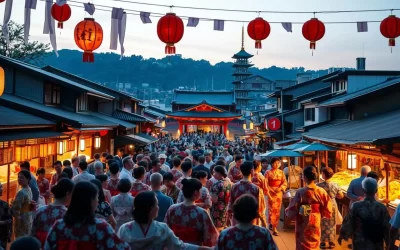You’re about to explore one of Tokyo’s most vibrant districts, where modern attractions and traditional Japanese culture blend seamlessly. Located in the heart of the city, Chūō-ku is a must-visit place that offers an authentic Tokyo experience.
This bustling ward is home to some of Tokyo’s most iconic attractions, from luxury shopping districts to peaceful traditional gardens and historic temples. As you navigate this lively area, you’ll discover the perfect blend of city life and historical significance, making the most of your time in this incredible district.
With its unique blend of culture and history, Chūō-ku is an ideal destination for travelers seeking an authentic Tokyo experience.
Discovering Chūō-ku: Tokyo’s Central Ward
Chūō-ku, situated at the core of Tokyo, is a bustling area known for its dynamic atmosphere and diverse attractions. As the central ward of Tokyo, it plays a pivotal role in the city’s economic and cultural landscape.
Where Is Chūō-ku Located?
Chūō-ku is strategically located in the heart of Tokyo, making it a significant business district with excellent connectivity to other parts of the city. This ward is home to Nihonbashi, a place filled with towering skyscrapers and corporate powerhouses like the Bank of Japan and Tokyo Stock Exchange.
The geographical boundaries of Chūō-ku are well-defined, with the ward being surrounded by other major areas of Tokyo. This connectivity makes Chūō-ku an ideal base for exploring the city, with numerous transportation options available.
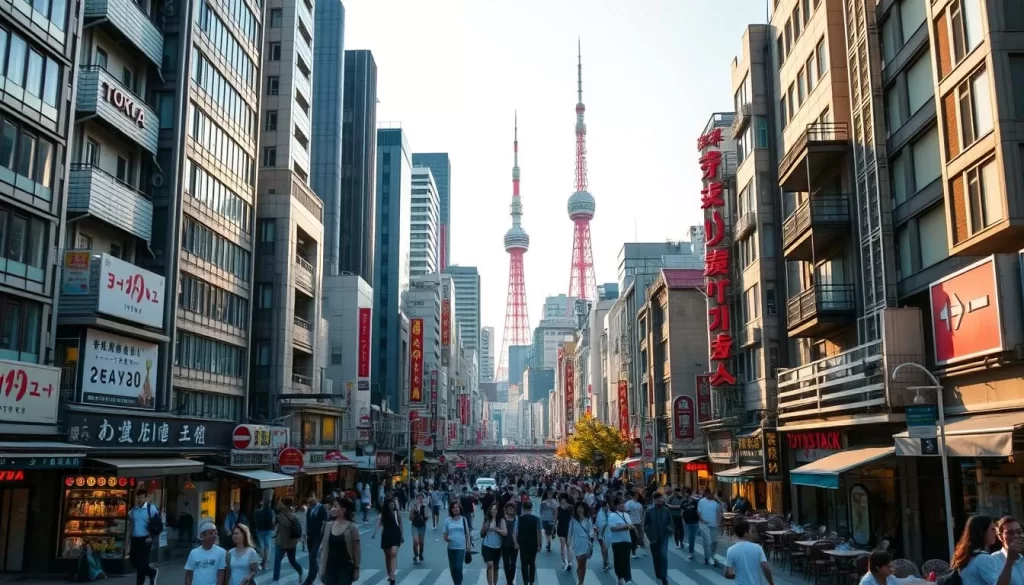
One of the key features of Chūō-ku is its diverse neighborhoods, each with its unique character and attractions. From the upscale district of Ginza, known for its high-end shopping and dining, to the historic Nihonbashi, with its rich cultural heritage, there’s something for everyone in Chūō-ku.
| Neighborhood | Key Attractions | Atmosphere |
|---|---|---|
| Ginza | High-end shopping, luxury hotels | Upscale, sophisticated |
| Nihonbashi | Historic landmarks, business centers | Bustling, traditional |
| Tsukiji | Outer Market, seafood restaurants | Lively, seafood-centric |
Chūō-ku’s central location and excellent connectivity make it one of the most visited areas in Tokyo, attracting both business travelers and tourists. Whether you’re looking to experience the business side of Tokyo or explore its cultural place in history, Chūō-ku has something to offer.
The Historical Significance of Chūō-ku
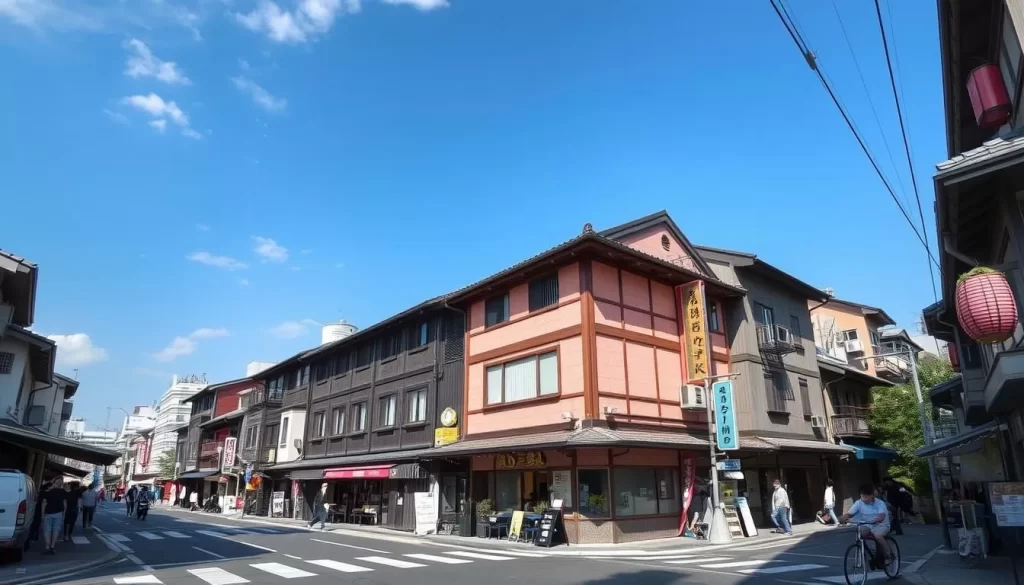
As you step into Chūō-ku, you’re not just walking into a modern Tokyo ward; you’re stepping into a living, breathing museum of history and tradition. This district has a rich history that dates back to the Edo period when it served as a vital commercial center for the growing city of Tokyo.
Over time, Chūō-ku has evolved significantly, yet it has managed to preserve important elements of its cultural and architectural heritage. The district’s ability to balance modernization with the preservation of its past is a testament to its resilience and the importance of its culture.
Let’s delve deeper into the historical significance of Chūō-ku:
- Delve into the rich history of Chūō-ku, which dates back to the Edo period when it served as a vital commercial center for the growing city of Tokyo.
- Discover how Chūō-ku has evolved over time while preserving important elements of its cultural and architectural heritage.
- Learn about the significant historical events that have shaped this district, including how it recovered and rebuilt after major disasters like the Great Kanto Earthquake.
- Understand the traditional roots that continue to influence modern life in Chūō-ku, creating a fascinating blend of old and new throughout the area.
- Explore how historical preservation efforts have maintained the district’s connection to its past while allowing for contemporary development and growth over time.
Chūō-ku’s history is not just about the past; it’s a living, breathing part of the district’s present. As you explore the area, you’ll find that the traditional and the modern coexist in harmony, creating a unique and captivating atmosphere that reflects the district’s tradition and culture.
How to Get Around Chūō-ku

Discover the ease of traveling within Chūō-ku, where multiple transportation modes await. Chūō-ku is a hub of activity, with various options to navigate this vibrant area of Tokyo.
To make the most of your time in Chūō-ku, it’s essential to master the efficient public transportation options that connect this ward to the rest of the city. The extensive subway and train networks make navigating Tokyo a breeze. You can easily plan trips to other parts of the city from here.
- Learn about the major train stations in Chūō-ku, including Tokyo Station, which serves as a central hub for both local and long-distance travel.
- Discover the convenience of walking between many major attractions in Chūō-ku, as several key sites are located within comfortable walking distance of each other.
- Understand how to use taxis effectively in this area when you’re short on time or carrying shopping bags from Ginza’s luxury boutiques.
- Get tips on the best times to travel within Chūō-ku to avoid rush hour crowds, especially if you’re planning day trips to other parts of Tokyo from this central place.
By understanding the transportation options available, you can enjoy a hassle-free experience exploring Chūō-ku and its many attractions, making your visit to this place truly memorable.
Explore the Luxurious Ginza District
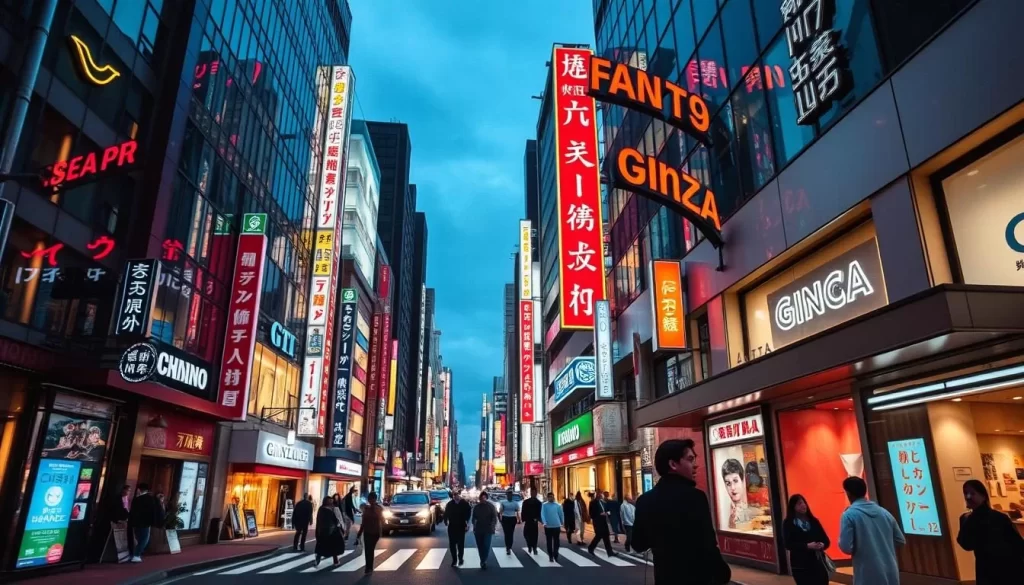
Discover the sophisticated charm of Ginza, a district that embodies Tokyo’s luxurious side. As you stroll through this iconic area, you’ll be surrounded by high-end boutiques, art galleries, and some of the city’s most exquisite restaurants.
High-End Shopping on Chuo-dori
Ginza is synonymous with luxury shopping. Chuo-dori, the main avenue, is lined with prestigious department stores and exclusive boutiques. You can indulge in retail therapy at iconic brands, exploring the latest fashion trends and designer collections.
Visit Ginza Sony Park
Ginza Sony Park offers a unique experience, blending technology and art in an urban park setting. You can explore interactive installations, enjoy events, and relax in this innovative space that reflects the fusion of technology and creativity.
Japan’s First Starbucks in Ginza
Even your coffee break can be a luxurious experience in Ginza. Visit Japan’s first Starbucks store, which offers a unique blend of coffee culture and Ginza’s upscale atmosphere. It’s a great place to take a moment to yourself amidst the bustling district.
Nightlife in Ginza
As night falls, Ginza transforms into a vibrant experience, offering a sophisticated atmosphere that is hard to find elsewhere in the city. You can enjoy a night out at exclusive hostess clubs, high-end lounges, or unique jazz clubs. The district is also home to numerous restaurants that come alive at night, serving everything from traditional kaiseki to innovative fusion cuisine.
To make the most of Ginza’s experience, understanding the local etiquette is key. Some establishments may have dress codes or require reservations, so it’s wise to plan ahead. Whether you’re looking for a relaxed evening or an upscale night out, Ginza has something to offer.
Experience Traditional Japanese Culture at Kabuki-za Theatre

Immerse yourself in the rich cultural heritage of Japan at the iconic Kabuki-za Theatre, a place where tradition and art come alive through the classical Japanese dance-drama known as kabuki.
History of Kabuki-za
The Kabuki-za Theatre, established in 1889, is the largest and most prominent kabuki theater in Tokyo, having been rebuilt several times to preserve its historical significance and architectural beauty. It stands as a testament to the enduring appeal of kabuki, an art form that has captivated audiences for centuries.
How to Purchase Tickets
To experience kabuki, you first need to purchase tickets. This can be done online through the official Kabuki-za website or at the theater’s ticket office. It’s advisable to book in advance, especially for popular performances, to ensure availability.
Understanding Kabuki Performances
Kabuki is known for its stylized performances, elaborate makeup, and costumes. The plays range from historical dramas to domestic stories, offering a glimpse into Japan’s cultural tradition. Even if you don’t understand Japanese, the artistic elements of kabuki, including its distinctive makeup patterns, costumes, and stage movements, make it a visually striking experience. The traditional musical accompaniment enhances the dramatic storytelling, drawing you into a world of timeless beauty.
As you watch a kabuki performance, you’ll notice the intricate details of the actors’ makeup and costumes, each carrying symbolic meanings that add depth to the story. Understanding these elements can enrich your experience, allowing you to appreciate the nuances of this ancient art.
When attending a kabuki performance, it’s helpful to know the etiquette. Generally, applause is reserved for the end of acts or particularly impressive scenes. Showing appreciation through applause at the right moments can enhance your overall experience and connection to the performance.
Relax at Hamarikyu Gardens
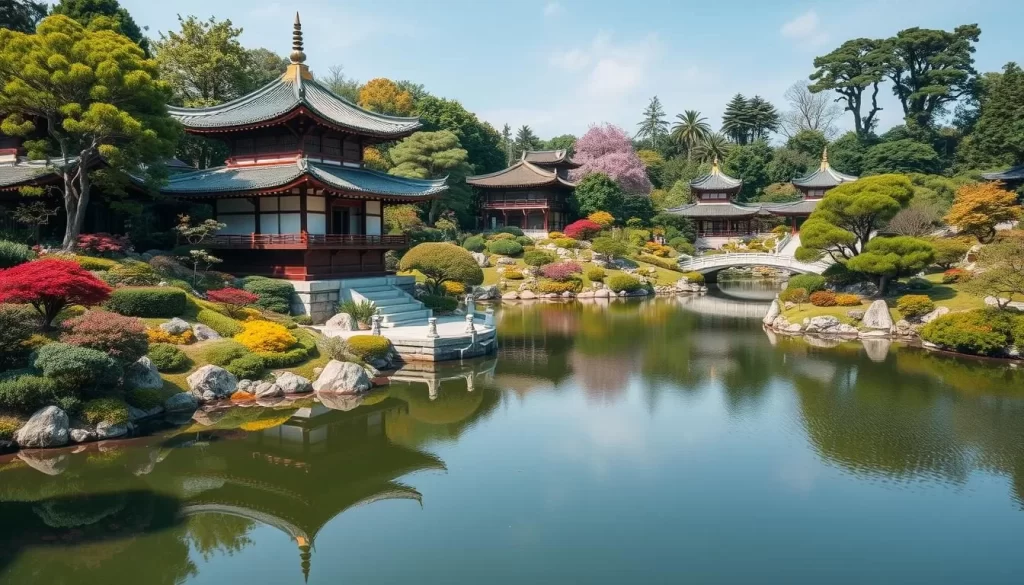
Located at the mouth of the Sumida River, Hamarikyu Gardens offer a tranquil retreat from the bustling city of Tokyo. These traditional Japanese strolling gardens are a haven for visitors seeking peace and natural beauty.
The History of These Traditional Japanese Gardens
Hamarikyu Gardens have a rich history dating back to the Edo period. Originally, the gardens served as a duck hunting ground for the shoguns. Over time, they evolved into a popular spot for hanami (cherry blossom viewing) and other leisure activities.
Tea Ceremony at the Garden Teahouses
One of the highlights of visiting Hamarikyu Gardens is the opportunity to participate in a traditional Japanese tea ceremony at one of the garden’s teahouses. Visitors can enjoy matcha (green tea) and wagashi (Japanese sweets) while taking in the serene surroundings.
Best Seasons to Visit Hamarikyu
The gardens are beautiful throughout the year, but the best time to visit depends on your preferences. Spring brings cherry blossoms, summer offers lush greenery, autumn is known for its vibrant foliage, and winter provides a serene landscape.
Practical Information for Visitors
To make the most of your visit, here are some tips:
- Check the opening hours and admission fees before you go.
- Use the water bus service to enjoy a scenic route to other Tokyo attractions like Asakusa.
- Explore the facilities within the gardens, including rest areas and refreshment spots.
- Be mindful of the photography policies and any seasonal restrictions.
- Plan your walking route and allocate sufficient time to explore the gardens.
Enjoy the water features, including the saltwater pond that is a remnant of the old Edo-period duck hunting ground.
Discover the Historic Nihonbashi District
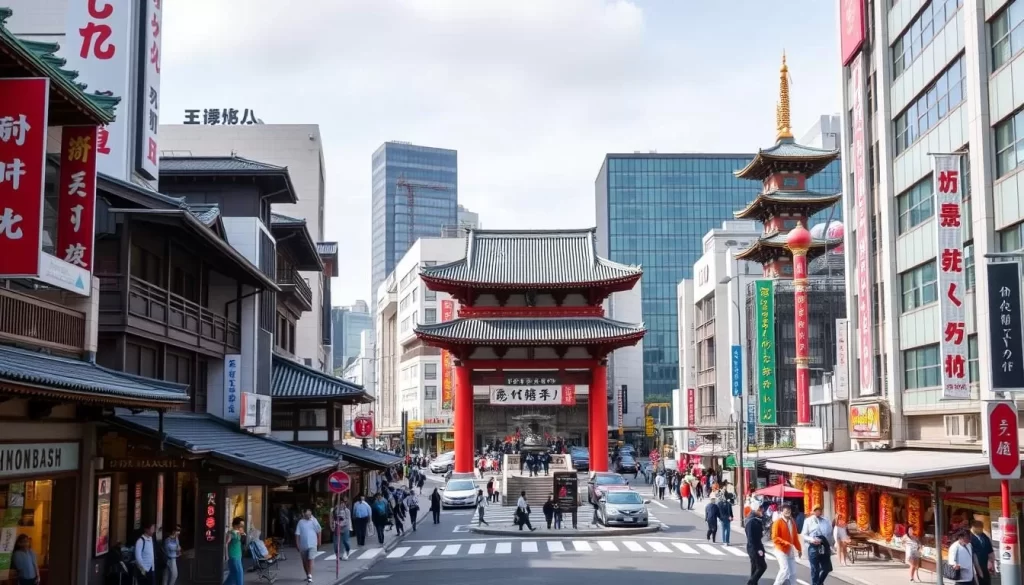
Nihonbashi, a district steeped in history, offers a fascinating glimpse into Tokyo’s rich cultural heritage. As you explore this iconic area, you’ll discover a blend of traditional and modern attractions that showcase the city’s diverse identity.
The Iconic Nihonbashi Bridge
The Nihonbashi Bridge is a historic landmark that has been a symbol of Tokyo since the early 17th century. This iconic bridge has witnessed the city’s transformation over the centuries and remains a significant cultural icon. You can appreciate its historical importance and enjoy the surrounding area, which is filled with traditional shops and restaurants.
Shopping at COREDO Muromachi
For a modern shopping experience, head to COREDO Muromachi, a complex that offers a variety of stores, restaurants, and services. You can find everything from high-end fashion to unique local goods, making it an ideal destination for shoppers looking for a blend of traditional and contemporary products.
Visit the Bank of Japan and Tokyo Stock Exchange
Nihonbashi is also home to significant financial institutions, including the Bank of Japan and the Tokyo Stock Exchange. While these institutions are primarily functional, they offer insight into Japan’s economic history and current financial landscape. Visitors can learn about the country’s financial systems and the role these institutions play in the global economy.
Mitsui Memorial Museum
The Mitsui Memorial Museum is a treasure trove of Eastern art and culture, housed within the historic Mitsui Main Building. The museum’s collection includes an impressive array of traditional Japanese and East Asian art, featuring calligraphy, ceramics, paintings, and tea ceremony utensils. The building itself is an Important Cultural Property, representing the Western-influenced design of the Taisho era. By visiting this museum, you gain a deeper understanding of Japan’s history and culture, as well as the Mitsui family’s significant contribution to the country’s artistic heritage.
As you explore the Mitsui Memorial Museum, you’ll appreciate the carefully curated exhibitions that provide insights into Japanese aesthetic traditions. The museum’s intimate setting allows for a more personal experience compared to larger museums in Tokyo, making it a unique destination for art enthusiasts and historians alike.
Explore the Former Tsukiji Fish Market Area
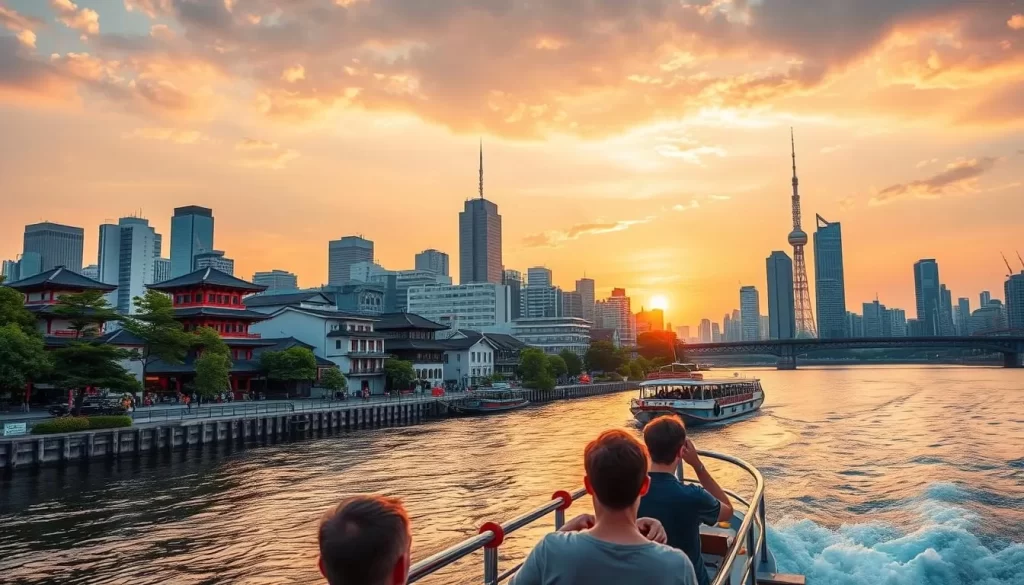
As you explore Chūō-ku, Tokyo, you’ll discover the vibrant former Tsukiji Fish Market area, rich in history and cultural significance. This area, once the bustling heart of Tokyo’s seafood trade, now offers a unique blend of traditional and modern attractions.
Shopping at Tsukiji Outer Market
While the inner market has moved to a new location, the Tsukiji Outer Market still retains its charm, offering a wide range of fresh seafood, sushi, and local specialties. You can explore the stalls selling everything from sushi-grade tuna to exotic fruits, and enjoy a meal at one of the many restaurants.
Best Seafood Restaurants in Tsukiji
Tsukiji is renowned for its fresh seafood, and you’ll find numerous restaurants serving sushi, sashimi, and other seafood delicacies. From high-end sushi establishments to casual eateries, there’s something for every taste and budget.
Namiyoke Shrine: The Guardian of Tsukiji
Namiyoke Shrine, built in 1659 on reclaimed land, is dedicated to Inari Okami, a major deity in the Shinto faith. It serves as the guardian shrine of the Tsukiji Fish Market and its workers. The shrine’s name, meaning “protection from waves,” reflects its historical significance in protecting the reclaimed land from the sea.
The shrine plays a vital role in the spiritual lives of market workers, who pray for business success and safety. You can experience traditional rituals and festivals, such as the Toka Ebisu Festival in January and the Fukagawa Hachiman Festival in summer.
The various offerings and ema (wooden prayer plaques) at the shrine often feature fish and seafood motifs, highlighting its connection to the market. This shrine represents the deep connection between spiritual practices and daily working life in traditional Japanese culture.
Visit Tsukiji Hongan-ji Temple
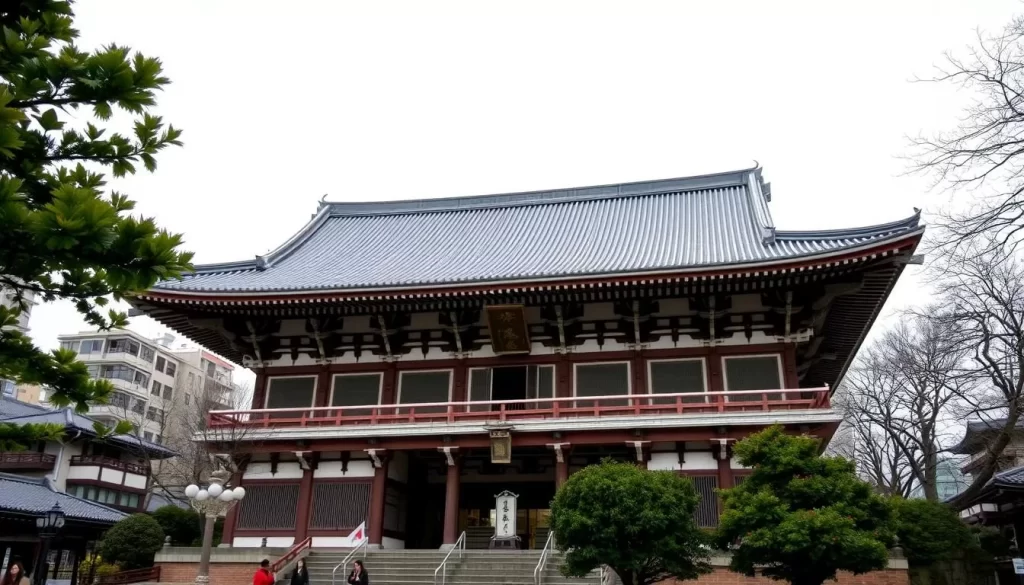
Located in the heart of Tokyo, Tsukiji Hongan-ji Temple is a must-visit destination for anyone interested in history, culture, and spirituality. This significant Buddhist temple is known for its unique architecture and rich cultural heritage.
The Unique Architecture of Tsukiji Hongan-ji
The temple’s design is a blend of traditional Japanese and Indian styles, making it a standout landmark in Tokyo. Its impressive main hall features a large pipe organ, creating a serene atmosphere for visitors.
History and Cultural Significance
Originally known as the Edo-Asakusa Gobo and located in Asakusa in 1617, Tsukiji Hongan-ji has a deep-rooted history. It has been a place of worship and spiritual guidance for centuries, offering a unique cultural experience for those who visit.
Visitor Information and Etiquette
When planning your visit, it’s essential to know that the temple is open to visitors free of charge. To make the most of your experience, consider visiting during less busy times. Here are some tips to ensure a respectful visit: dress modestly, be mindful of your behavior in worship areas, and respect any ongoing ceremonies. Attending a service can be a profound experience, offering insights into living Buddhist traditions.
For the best experience, take your time to explore the various parts of the temple complex, including the peaceful inner gardens and the main hall. Don’t miss the special events and concerts held throughout the year, which are great opportunities to engage with the local culture and community.
Stroll Along the Sumida River
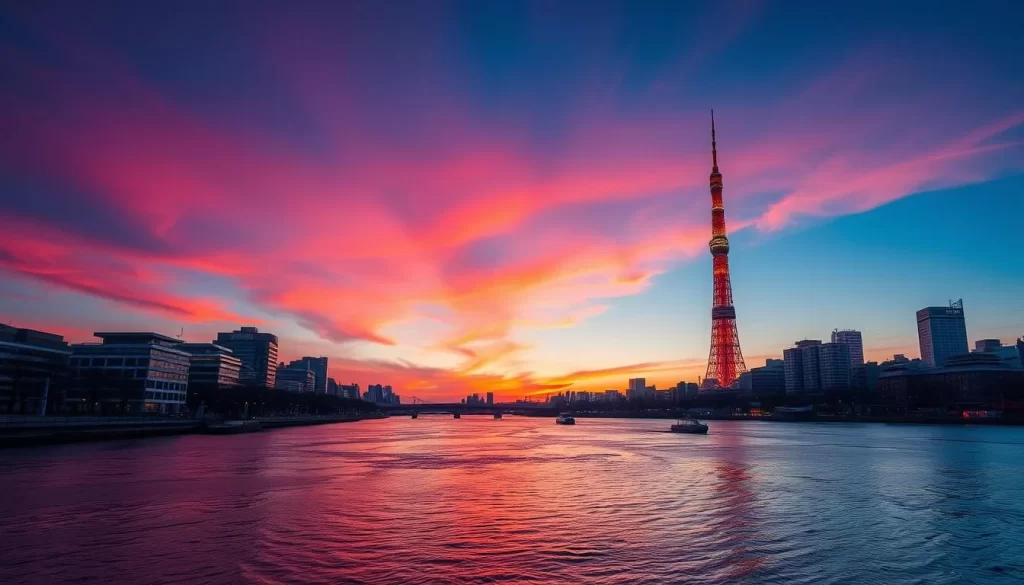
Strolling along the Sumida River is a must-do experience in Tokyo, providing a fresh perspective on the city’s iconic landmarks. As you walk along the riverbank, you’ll be treated to stunning views of Tokyo’s skyline, including the majestic Tokyo Skytree.
Scenic Walking Routes
The Sumida River offers several scenic walking routes that cater to different interests and preferences. You can start at the Asakusa district and walk towards the Tokyo Skytree, enjoying the mix of traditional and modern architecture along the way. Alternatively, you can explore the riverbank near Hamarikyu Gardens, where the contrast between the natural beauty of the gardens and the modern cityscape creates a unique visual experience.
River Cruises and Dinner Boats
For a more leisurely experience, consider taking a river cruise or dining on a dinner boat. From the boat, you’ll have the opportunity to enjoy views of some of Tokyo’s most iconic landmarks, including Tokyo Skytree, Odaiba, and the Rainbow Bridge, as well as the illuminated skyline of Tokyo Bay at night.
Best Spots for Photography
The Sumida River is a photographer’s paradise, with numerous spots offering perfect angles for capturing Tokyo’s iconic skyline. Some of the top photography spots include the Azuma Bridge, which frames Tokyo Skytree beautifully, and the area near Hamarikyu Gardens, where the contrast between modern buildings and traditional garden elements creates a visually appealing scene.
To make the most of your photography experience, consider visiting during the early morning or evening when the light is soft and the city lights reflect beautifully on the water’s surface. Additionally, be mindful of the seasonal changes, as spring cherry blossoms and autumn leaves can add colorful frames to your river views.
Explore the Monja Street in Tsukishima
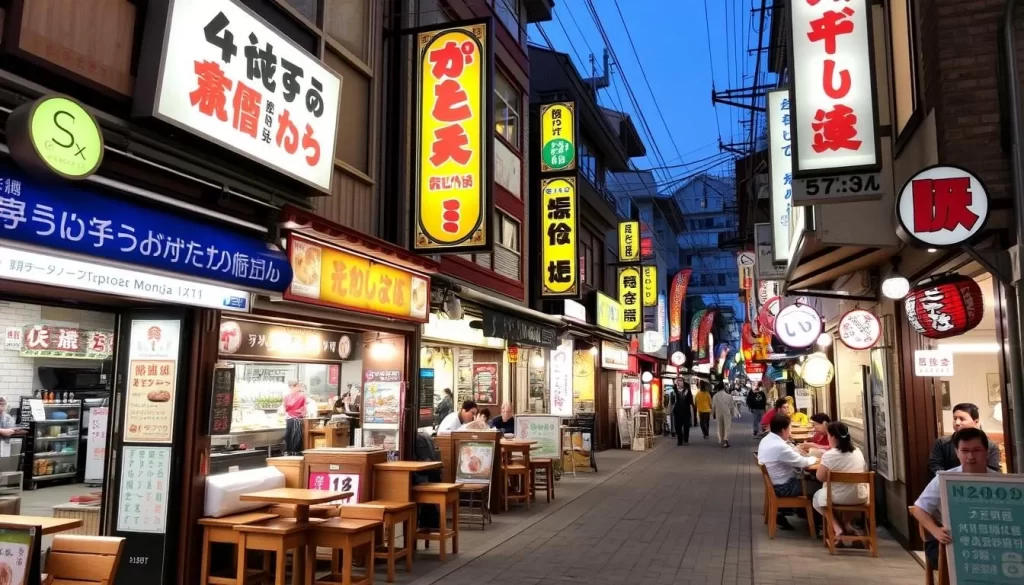
Monja-yaki, a savory pancake-like dish, is the highlight of Tsukishima, a charming waterfront area in Tokyo. As you stroll along Monja Street, you’ll be greeted by the aroma of sizzling monja-yaki and the lively atmosphere of restaurants inviting you to try this local delicacy.
The Delicacy of Monja-yaki
Monja-yaki is a type of Japanese savory pancake that is similar to okonomiyaki but has a runnier batter and is cooked on a hot iron griddle. This food experience is not just about eating; it’s an interactive culinary adventure where you get to cook your meal yourself.
Top Monja-yaki Restaurants to Try
Tsukishima is home to numerous restaurants serving monja-yaki, each with its unique twist. Some top recommendations include:
- Tsukishima Monja-yaki Mizukami: Known for its high-quality ingredients and traditional cooking methods.
- Monja Kyoukaikan: Offers a variety of monja-yaki flavors and a cozy dining atmosphere.
How to Cook and Eat Monja-yaki
Cooking monja-yaki is an art that requires some tips and tricks. Here’s how to do it:
- Start by mixing and spreading the runny batter on the griddle to create a circle.
- Add your preferred ingredients to the center and let it cook until the edges start to crisp.
- Use a specialized metal spatula to mix everything together and scrape the crispy bits from the griddle.
As you enjoy your monja-yaki, you’ll feel like you’re experiencing a true food culture of Tokyo. The key is to cook it just right and enjoy it with your companions, making it a memorable dining experience at this popular place.
For the best experience, be sure to follow local etiquette, such as sharing your monja-yaki with your dining companions and adding the right condiments for an authentic taste.
Shop at Amazake Yokocho

For a taste of old Japan, head to Amazake Yokocho, a charming shopping street that embodies the traditional spirit of Tokyo. This small shopping strip exudes an old-time atmosphere with its collection of traditional Japanese snack vendors, restaurants, and quaint boutiques.
History of “Sweet Sake Alley”
Amazake Yokocho, also known as “Sweet Sake Alley,” has a rich history dating back to the post-war period. It was originally known for its amazake, a traditional Japanese sweet sake, but over time, it evolved into a vibrant shopping street with a variety of vendors.
Traditional Japanese Snacks to Try
One of the highlights of visiting Amazake Yokocho is the opportunity to try traditional Japanese snacks. From senbei (Japanese crackers) to other local delicacies, you’ll find a variety of flavors to sample. The vendors here offer a genuine taste of Japanese street food, making it a must-visit for food enthusiasts.
Boutique Shopping Experience
Amazake Yokocho is not just about food; it’s also a shopper’s paradise. The alley is lined with small, independent boutiques selling everything from traditional crafts to vintage items. You’ll have the chance to explore unique boutique shopping and discover specialty stores that maintain traditional Japanese craftsmanship, offering products like handmade paper goods, traditional textiles, and artisanal kitchenware.
Shopping in this historic alley differs significantly from the department store experience elsewhere in Tokyo. Here, you can enjoy personal service and interact with shop owners who are often the artisans themselves. To make the most of your visit, be prepared to navigate the sometimes cramped spaces and engage with shopkeepers who may speak limited English.
As you stroll through Amazake Yokocho, you’ll appreciate how this shopping street preserves a slower, more personal retail experience that feels like stepping back in time compared to Tokyo’s modern shopping districts. It’s an experience that combines traditional flavors, unique shopping, and a nostalgic atmosphere, making it a place you won’t soon forget.
Visit Tokyo Station and Marunouchi Area
Your journey through Chūō-ku, Tokyo, isn’t complete without experiencing the grandeur of Tokyo Station and the sophistication of the Marunouchi area. This vibrant district is a must-visit for anyone interested in history, business, and modern city life.
The Historic Tokyo Station Building
Tokyo Station, with its historic building, is an iconic landmark that has been in operation since 1914. The station’s red brick architecture is a beautiful example of modern Meiji-era design, blending seamlessly with the surrounding business district.
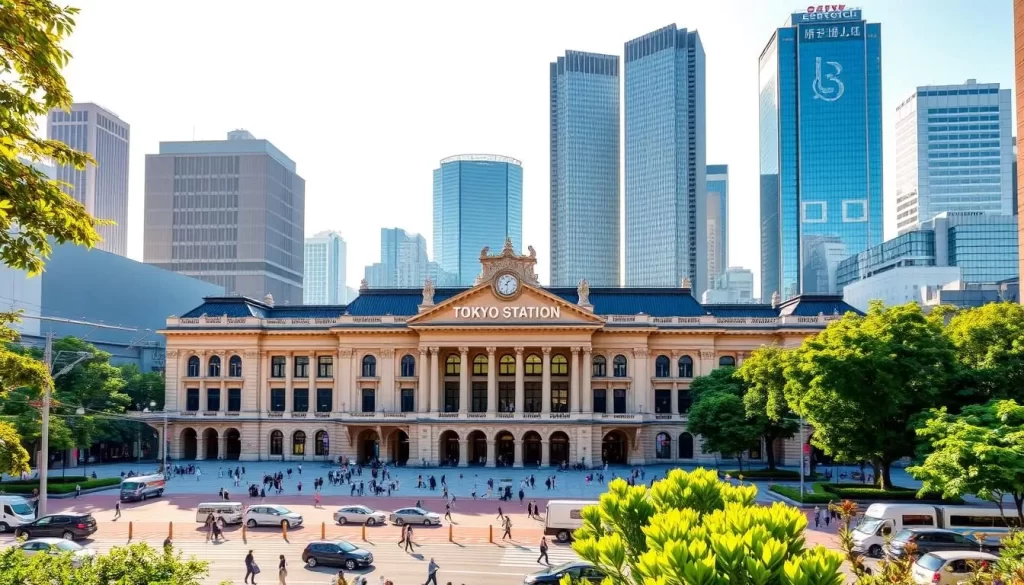
Tokyo Station Gallery
For art enthusiasts, the Tokyo Station Gallery is a hidden gem located within the station. It hosts various exhibitions throughout the year, showcasing works by Japanese and international artists. The gallery’s presence adds a touch of culture to the bustling city environment.
Shopping at Tokyo Station City
Tokyo Station City is a shopper’s paradise, offering a wide range of products from souvenirs to high-end fashion. The complex includes several shopping floors, with the underground level featuring a variety of food options and unique local products. Visitors can enjoy a day of shopping in this area, exploring the different stores and restaurants available.
Marunouchi Business District
The Marunouchi district, located just outside Tokyo Station, is Tokyo’s prestigious business area. Known for its concentration of corporate headquarters and financial institutions, it’s a hub of activity during the week. The district has undergone significant redevelopment, incorporating modern architecture while preserving some of its historic charm.
| Aspect | Tokyo Station | Marunouchi District |
|---|---|---|
| Historical Significance | Built in 1914, iconic red brick building | Formerly a feudal military zone, now Japan’s premier business center |
| Main Attractions | Tokyo Station Gallery, Shopping at Tokyo Station City | Marunouchi Building, modern skyscrapers, public art installations |
| Atmosphere | Bustling with travelers and locals alike | Bustling during weekdays, relaxed on weekends |
As you explore the Marunouchi district, you’ll notice the blend of modern skyscrapers and historic buildings, creating a unique cityscape. The area is not just about business; it’s also a place where you can enjoy upscale shopping and dining, especially on weekends when the atmosphere becomes more relaxed.
Experience TeamLab Planets or Borderless
Tokyo’s TeamLab Planets and Borderless museums are revolutionizing the way we experience art with their interactive digital installations. These two exhibitions, while sharing the same creative force, offer distinct experiences that cater to different interests and preferences.
What is TeamLab?
TeamLab is a renowned collective of artists, programmers, engineers, and mathematicians who collaborate to create immersive digital art exhibitions. Their work combines technology, art, and design to produce interactive and engaging experiences that challenge the boundaries between the physical and digital worlds.
TeamLab Planets vs. Borderless
TeamLab Planets is an immersive, interactive experience where visitors can walk through and engage with various digital artworks, often involving water, light, and sound. On the other hand, TeamLab Borderless is a museum featuring a vast array of digital art installations that are interconnected, allowing visitors to explore a continuous, borderless world of art.
Here’s a comparison of the two exhibitions:
| Exhibition | Location | Hours | Entrance Fee (Adults) |
|---|---|---|---|
| TeamLab Planets | Toyosu 6-1-16, Koto-ku, Tokyo | 10 a.m. – 9 p.m. | 3,200 Yen (~$23 USD) |
| TeamLab Borderless | Azabudai Hills Garden Plaza B B1, 1-2-4 Azabudai, Minato-ku, Tokyo | Monday – Friday: 9:00 a.m. – 5:00 p.m.; Saturday – Sunday and holidays: 10:00 a.m. – 7:00 p.m. | 3,800 Yen (~$25 USD) |
Tips for Visiting
To make the most of your visit, it’s essential to plan ahead. Purchasing tickets in advance is highly recommended, as both exhibitions can sell out quickly, especially during peak tourist seasons.
Here are some additional tips:
- Arrive early to avoid the crowds.
- Wear comfortable shoes, as you’ll be doing a lot of walking.
- Be prepared for interactive experiences that may involve water or other elements.
How to Purchase Tickets
Tickets for both TeamLab Planets and Borderless can be purchased through their official websites. It’s advisable to buy tickets well in advance, as availability is limited, and popular time slots fill up quickly.
Additionally, consider checking for any special packages or discounts that might be available, such as combo tickets or promotions through certain hotels or tour operators.
Chūō-ku, Tōkyō, Japan: Best Things to Do for Foodies
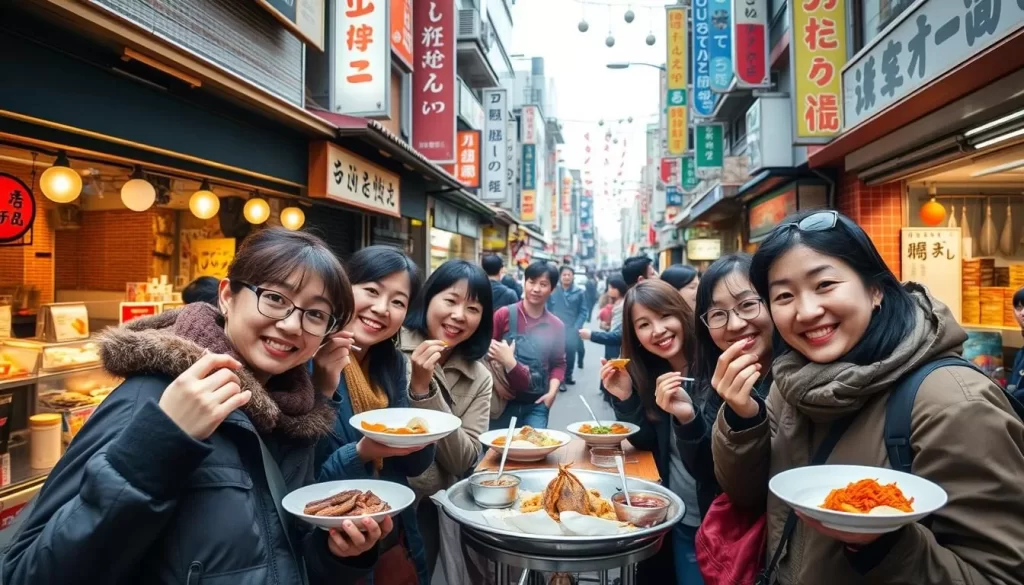
The culinary scene in Chūō-ku, Tokyo, is a melting pot of traditional and modern flavors. As a food enthusiast, you’ll find numerous options to indulge in the local cuisine.
Michelin-Starred Restaurants
Chūō-ku is home to several Michelin-starred restaurants, offering an unparalleled fine dining experience. These restaurants serve exquisite cuisine, from sushi to kaiseki, and are a must-visit for any food connoisseur.
Traditional Japanese Cuisine Experiences
For a truly immersive culinary experience, try traditional Japanese cuisine at local restaurants. You can enjoy a range of dishes, from tempura to yakitori, and even participate in a cooking class to learn the art of Japanese cuisine.
Food Tours in Chūō-ku
One of the best ways to experience the food scene in Chūō-ku is by joining a guided food tour. These tours allow you to sample a variety of dishes, from popular street food to high-end restaurant cuisine, while learning about the local culinary culture.
Some of the benefits of joining a food tour include:
- Discovering the variety of food tours available in Chūō-ku, which allow you to sample multiple Japanese specialties while learning about the area’s culinary history from knowledgeable guides.
- Learning about specialized tours focusing on specific aspects of Japanese cuisine, such as market tours in the Tsukiji Outer Market area or sake tasting experiences in Nihonbashi.
- Exploring how food tours can provide access to hidden local establishments you might not discover on your own, including family-run restaurants that have perfected specific dishes over generations.
- Understanding the advantages of joining a guided food tour, including cultural context for what you’re eating and assistance with navigating menus and ordering in Japanese-only establishments.
- Getting recommendations for highly-rated food tour companies operating in Chūō-ku, with options ranging from small-group walking tours to private customized culinary experiences.
Best Time to Visit Chūō-ku
Planning a trip to Chūō-ku, Tokyo, requires more than just knowing the top attractions; it demands timing your visit perfectly. The central ward of Tokyo is a vibrant area that offers a unique experience throughout the year, but certain times are better than others to make the most of your visit.
Seasonal Highlights and Festivals
Chūō-ku is a year-round destination, with each season bringing its own charm. Spring (March to May) is a beautiful time to visit, with the cherry blossoms blooming in late March to early April. Summer (June to August) is peak tourist season, with many festivals and events taking place, such as the Mitama Matsuri at Yasukuni Shrine. Autumn (September to November) brings comfortable temperatures and the changing foliage, making it an ideal time for outdoor activities. Winter (December to February) is the low season, but it has its own charm, especially during the New Year (Oshogatsu) celebrations.
Some of the key festivals and events include:
- The Cherry Blossom Festival (Hanami) in spring
- Summer festivals like the Mitama Matsuri
- Autumn Leaves (Koyo) in the fall
- New Year (Oshogatsu) celebrations in winter
Weather Considerations
Tokyo’s climate is temperate, with significant seasonal variations. Spring and autumn are generally considered the best times to visit due to their mild and pleasant weather. Summer can be hot and humid, while winters are cool but not typically cold.
| Season | Weather | Best For |
|---|---|---|
| Spring | Mild, pleasant | Cherry blossoms, comfortable sightseeing |
| Summer | Hot, humid | Festivals, outdoor events |
| Autumn | Mild, pleasant | Autumn leaves, comfortable sightseeing |
| Winter | Cool | New Year celebrations, fewer tourists |
Avoiding Crowds
To avoid the crowds, consider visiting popular spots like Tsukiji Outer Market or Hamarikyu Gardens early in the morning or later in the evening. Understanding how Japanese national holidays and school vacation periods impact visitor numbers can also help you plan a more peaceful experience.
Here are some tips for avoiding crowds:
- Visit major attractions during less busy times of the day.
- Explore alternative spots within Chūō-ku that offer similar experiences with fewer visitors.
- Consider visiting during the shoulder season (April-May or September-October).
By planning your visit at the right time and being aware of the local events and holidays, you can have a more enjoyable and less crowded experience in Chūō-ku.
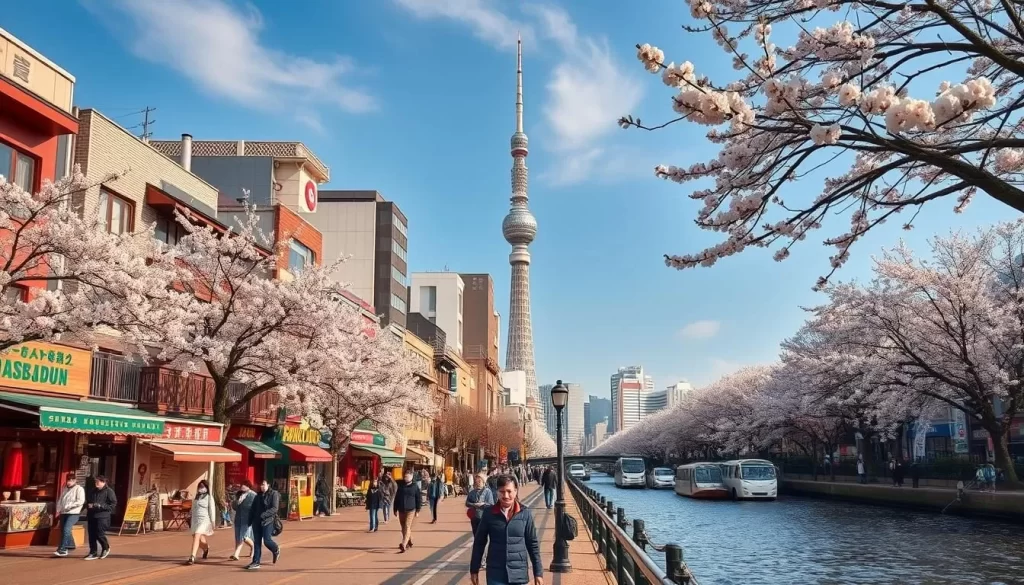
Where to Stay in Chūō-ku
Chūō-ku, Tokyo’s central ward, offers a diverse array of accommodations that cater to different budgets and preferences. Whether you’re looking for luxury, mid-range, or budget-friendly options, this area has something for everyone, making it an ideal place to stay while exploring the city.
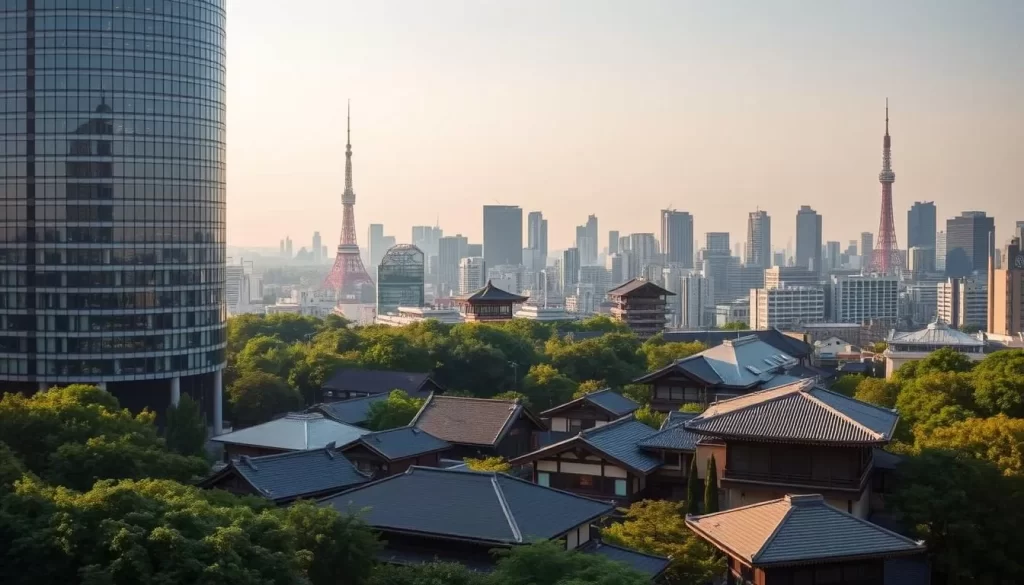
Luxury Accommodations
For those seeking a luxurious experience, Chūō-ku is home to some of Tokyo’s most prestigious hotels. These establishments offer top-notch amenities, exceptional service, and often, stunning views of the city. Many are located in prime locations, such as Ginza or near Tokyo Station, providing easy access to major spots.
Mid-Range Options
Travelers on a moderate budget can find comfortable and convenient accommodations in Chūō-ku. Business hotels and boutique hotels are plentiful, offering a range of amenities and services. These options are ideal for those who want to be in the heart of the action without the high costs associated with luxury hotels.
Budget-Friendly Choices
For budget-conscious travelers, Chūō-ku offers several affordable accommodation choices. Business capsule hotels are a unique and cost-effective option, providing clean, efficient sleeping spaces with shared facilities. Affordable business hotel chains like APA Hotels and Toyoko Inn are also available, offering no-frills but comfortable accommodations in convenient areas.
When opting for budget-friendly options, it’s essential to understand the trade-offs, particularly regarding room size, which tends to be significantly smaller than Western standards. To find the best deals in this otherwise expensive area, consider booking strategies such as advance reservations or looking for less obvious budget options that might not appear on major booking sites.
- Discover budget-friendly accommodation options in and around Chūō-ku.
- Learn about business capsule hotels that offer efficient sleeping spaces at a fraction of the cost.
- Explore affordable business hotel chains that provide comfortable accommodations.
- Understand the trade-offs of budget accommodations, including smaller room sizes.
- Get tips on finding the best deals, including booking strategies and lesser-known budget options.
Conclusion: Making the Most of Your Visit to Chūō-ku
With its unique blend of old and new, Chūō-ku is an essential part of any Tokyo itinerary, providing visitors with a rich and diverse experience. As you’ve explored throughout this article, this central ward offers a wide range of activities and attractions that cater to all interests.
From the luxurious shopping districts like Ginza to the serene traditional gardens and temples, Chūō-ku seamlessly blends the city‘s vibrant energy with peaceful retreats. Whether you’re interested in history, culture, or entertainment, you’ll find that Chūō-ku has something to offer, making the most of your time in Tokyo.
To efficiently plan your trip, consider combining nearby attractions into sample itineraries tailored to your length of stay. For instance, a day could be spent exploring Ginza’s high-end shopping, followed by a visit to the historic Nihonbashi district, and ending with a stroll along the Sumida River. This approach allows you to maximize your time and enjoy a variety of experiences.
To enhance your experience, consider investing in transportation passes that simplify navigating this complex but rewarding part of city life. Additionally, utilizing local apps can help you discover hidden gems and make the most of your trip. As you explore, remember to balance planned highlights with spontaneous discoveries, allowing you to truly immerse yourself in the daily life of central Tokyo, making your visit to this place truly unforgettable.
By embracing both the structured and the serendipitous moments during your visit, you’ll create a memorable trip to Chūō-ku, taking back home a rich tapestry of memories from this vibrant city.
The above is subject to change.
Check back often to TRAVEL.COM for the latest travel tips and deals.
Here are some Tours & Sightseeing suggestions that might pique your interests!
